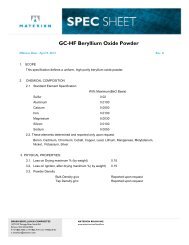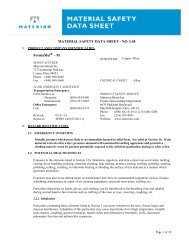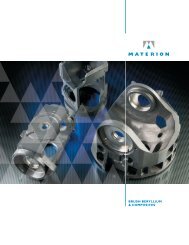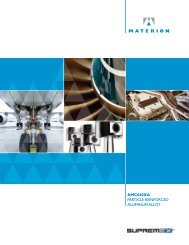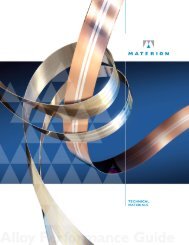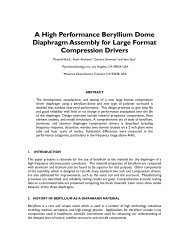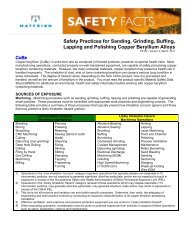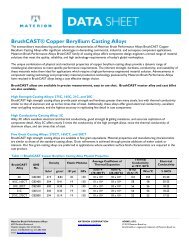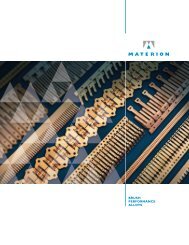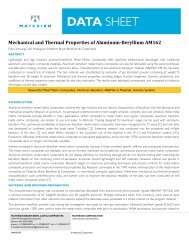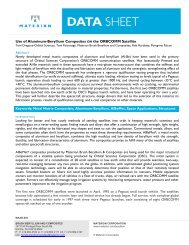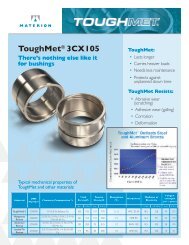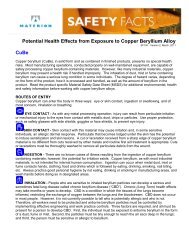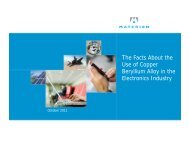Developing a Fundamental Understanding of Gold ... - Materion
Developing a Fundamental Understanding of Gold ... - Materion
Developing a Fundamental Understanding of Gold ... - Materion
You also want an ePaper? Increase the reach of your titles
YUMPU automatically turns print PDFs into web optimized ePapers that Google loves.
TECHNICAL PAPER<strong>Developing</strong> a <strong>Fundamental</strong> <strong>Understanding</strong> <strong>of</strong> <strong>Gold</strong> Spitting During Evaporation<strong>Materion</strong> Authors: Alan Duckham, Lawrence Luke, Robert SpragueAbstractWe report on studies focused on the electron-beam (E-Beam) evaporation <strong>of</strong> gold (Au) that have enabled us to developa fundamental understanding <strong>of</strong> the causes <strong>of</strong> spitting. We have found that the factors that affect spitting can be dividedinto two broad groups: 1) evaporation process parameters and 2) material quality. Process parameters that have aneffect on the heat input or heat loss <strong>of</strong> the system have the most influence on spitting. If these parameters are notcarefully regulated, an out <strong>of</strong> control process results with significant variation in spitting and the resulting measuredparticles. For a process that is in control, the quality <strong>of</strong> the Au plays a significant role in the degree <strong>of</strong> spitting. The level<strong>of</strong> purity, cleanliness, and the Au manufacturing methods were all shown to influence the amount <strong>of</strong> spitting.IntroductionSpitting during the evaporation <strong>of</strong> Au is the inadvertent ejection <strong>of</strong> liquid droplets from the melt pool which causedefects known as nodules or particles in the deposited film. These nodules can significantly affect production yields asthey can lead to device malfunction through the breakdown <strong>of</strong> layered structures. This is especially true <strong>of</strong> in a metalinsulator-metal(MIM) capacitor structure where nodules on an electrode layer can cause failure during operation [1].There is thus a compelling need to reduce the number <strong>of</strong> defects caused by spitting during the evaporation <strong>of</strong> Au. Inorder to do that, a thorough understanding <strong>of</strong> all the factors that contribute to spitting is required.MethodA Telemark 291 E-beam gun with copper turret containing six 40 cc pockets was used to deposit 2000 Å thick Au layersonto 100 mm diameter silicon (Si) wafers with the aid <strong>of</strong> titanium (Ti) adhesion layers. A 10 kV power supply set to 7 kVwas used. Quartz crystal microbalances were used to determine film thickness and deposition rate in-situ. A doublewafer holder shown in Fig. 1 was constructed for these trials. The bottom wafer received the deposition, while the topwafer served to monitor particulate pick-up from the chamber environment. Tungsten (W) and molybdenum (Mo)crucible liners with 30 cc and 40 cc capacities were used and Au levels were kept consistent by controlled additionsbetween runs (Fig. 2).Fig. 1 Double wafer holderFig. 2 Au replenishmentThe Au used for these studies was 99.999% (5N) pure. A programmable thin film controller was used to adjust appliedpower in order to maintain a rate set point <strong>of</strong> 10 Å/s. A standard ramp pr<strong>of</strong>ile was run under shutter before deposition.The beam was set in circular sweep pattern at 3 Hz for both the ramp pr<strong>of</strong>ile and the deposition time.
<strong>Developing</strong> a <strong>Fundamental</strong> <strong>Understanding</strong> <strong>of</strong> <strong>Gold</strong> SpittingDuring EvaporationFollowing deposition, particles larger or equal to 0.5 µm that were present in the Au layer were quantified with a KLA-Tencor 6420 wafer scanner. A gauge repeatability and reproducibility (Gauge R&R) study was conducted to quantify theamount <strong>of</strong> variance caused by the measuring system and the amount <strong>of</strong> variation was less than 10 % <strong>of</strong> the totalvariation. It was additionally confirmed that the Ti layer did not generate any particles due to spitting.Process ParametersChamber CleanlinessDuring initial trials thousands <strong>of</strong> particles were measured on the deposited Au layers. Scanning <strong>of</strong> the monitor wafersplaced in the top wafer holder (see Fig. 1) produced equivalent counts. This indicated severe particulate pick-up fromthe chamber environment. In response, the slow rough pumping time and the venting time were significantly increased.These actions resulted in negligible chamber environment particle pick-up.Heat TransferA series <strong>of</strong> trials were run using a 40 cc W crucible liner placed on top <strong>of</strong> a W shim in a 40 cc copper pocket. Theintention <strong>of</strong> using a shim is to raise the crucible liner sufficiently to prevent contact with the copper pocket wall, therebylimiting heat loss from the Au melt to the water cooled copper hearth. In so doing the power required to achieve agiven rate can be dramatically reduced. However, it was found that the measured power during deposition varied by upto a factor <strong>of</strong> 3 from run to run under nominal identical conditions – Fig. 3. It was also found that the amount <strong>of</strong> Auconsumed from run to run showed similar levels <strong>of</strong> variation. Close inspection <strong>of</strong> the placement <strong>of</strong> the crucible liner inthe copper pocket revealed occasional point contact between the liner and the pocket. The heat transfer between theAu melt and the copper hearth was therefore inconsistent. This is a good example <strong>of</strong> process instability. From run torun the Au melt heated up to different temperatures during the programmed power ramp and conditioning cycles(under shutter) because <strong>of</strong> the varying conditions <strong>of</strong> heat loss to the copper hearth. When the shutter opened andpower was under rate control, large differences in measured power were observed as a direct result <strong>of</strong> the differentstarting Au melt temperatures. A higher amount <strong>of</strong> spitting at higher powers might reasonably be expected and this isobserved as shown in Fig. 4.Fig. 3 (Left) Large variations in power were observed from run to run due to process instability resulting frominconsistent heat transfer.15.0Power Measured During Deposition for an Unstable ProcessUCL=15.56160140The Effect <strong>of</strong> Power Input on SpittingPower (%)12.510.07.55.0_X=9.55LCL=3.55Particles120100806040200123456 7 8 9 10Deposition Run11121314155.07.510.012.5Power During Deposition (%)15.0Fig. 4 (Right) Particles due to spitting showed a positive correlation (r = 0.79) with power during deposition.
<strong>Developing</strong> a <strong>Fundamental</strong> <strong>Understanding</strong> <strong>of</strong> <strong>Gold</strong> SpittingDuring EvaporationCrucible Liner WeightAnother process parameter which, if not controlled, can lead to process instability is crucible liner weight. It was foundthat crucible liner weights can vary by as much as 20 % even when they have the same nominal dimensions, are madefrom the same material and are purchased from the same vendor. Fig. 5 shows the measured power from a series <strong>of</strong>deposition runs from two Au melts made in 30 cc W crucible liners. Since these were 30 cc liners placed on W shims in a40 cc copper pocket there was a consistent gap created between the liner and the pocket and the process instabilitiesassociated with point contact referred to in the previous section were avoided. There was however a significantdifference in the weights <strong>of</strong> the two W liners: 175 g and 200 g. Fig. 5 shows quite clearly that the measured powersduring deposition were in distinctive ranges. Although this difference is not as extreme as that shown in Fig. 3, itnevertheless can be expected to influence the degree <strong>of</strong> spitting during the deposition <strong>of</strong> Au.Fig. 5 Different ranges <strong>of</strong> power during deposition were measured for two Au melts in 30 cc W crucible liners with different weightsCrucible Liner Material175 g Liner 200 g Liner6.00In terms <strong>of</strong> Au spitting, a more significant process5.75parameter than crucible liner weight was the materialtype <strong>of</strong> the crucible liner. Two distinct batches / lots <strong>of</strong>5.50Au were used to create four Au melts in 30 cc crucible5.25liners. Two melts were in W crucible lines and two melts5.00were in Mo crucible liners. Separate ramp pr<strong>of</strong>iles werecreated for the W and Mo crucible liner melts to account4.75for material density differences. In both cases the ramp4.50pr<strong>of</strong>iles were optimized to produce the same rate <strong>of</strong>1 3 5 7 9 11 13 15 17 19 21Deposition Rundeposition (10 Å/s). The particles due to spitting fromthe melts in the Mo crucible liners were measured to besignificantly higher compared to those from the melts in the Mo crucible liners. Fig. 6 illustrates this observation withaverage particles counts <strong>of</strong> 46 and 68 for the two melts in W compared to average particle counts <strong>of</strong> 11 and 4 for thetwo melts in Mo.PowerThe Effect <strong>of</strong> Crucible Liner Weight on Power RequiredFig. 6 Particles due to spitting were observed to be much lower for Au melts in Mo crucible liners compared to Au melts inW crucible linersParticles1601401201008060402001Influence <strong>of</strong> Crucible Liner Material on SpittingAu Batch 1 in W Au Batch 2 in W Au Batch 1 in Mo Au Batch 2 in Mo5_X=45.59_X=68.21317 21 25Deposition Run_X=11.1 _X=429333741Material QualityPurityAll the Au used in this study had a purity <strong>of</strong> atleast 99.999% as measured by Glow DischargeMass Spectroscopy (GDMS). This is consideredthe minimum purity required in order to preventexcessive spitting during evaporation sincevolatile elements with higher vapor pressures(compared to Au) are kept to a minimum [2].
<strong>Developing</strong> a <strong>Fundamental</strong> <strong>Understanding</strong> <strong>of</strong> <strong>Gold</strong> SpittingDuring EvaporationCleanlinessA further source <strong>of</strong> material contamination that is not easily detected by bulk measurements <strong>of</strong> purity is organic surfaceresidue. If the Au source material has appreciable surface organic residue then during melt formation and subsequentadditions, the organic material is transformed into a thin carbon film that floats over the top <strong>of</strong> the Au melt. The carbonfilm has the effect <strong>of</strong> reducing the effective area <strong>of</strong> the Au melt from which evaporation can occur. Under depositionrate controlled conditions, power is increased to compensate for the reduced evaporation area and the level <strong>of</strong> spittingsubsequently increases [3, 4]. In this study we monitored the surface cleanliness <strong>of</strong> Au source material with a ScanningElectron Microscope (SEM) using a back scattered electron detector that produces excellent contrast between organiccontaminants and the Au background. Fig. 7 shows two such SEM micrographs: one corresponding to a clean Au surfaceand one corresponding to a contaminated Au surface.Fig. 7 SEM micrographs <strong>of</strong> Au source material showing an example <strong>of</strong> a clean surface (left) and an organic contaminated surface (right).The effect <strong>of</strong> organic surface contamination on spitting was confirmed by E-Beam evaporation trials and subsequentmeasurement <strong>of</strong> particles. Fig. 8 is a plot <strong>of</strong> particles corresponding to two distinct Au material lots used to create twoAu melts in 30 cc W crucible liners. The first series plotted is that for a known clean Au material lot. Particle levels wereseen to be consistently low with an average count <strong>of</strong> 45. The second series plotted corresponds to a dirty Au materiallot with an average count <strong>of</strong> 637 particles after 7 runs. Following these 7 runs, the surface <strong>of</strong> the Au melt was wipedusing a lint free wipe soaked in isopropyl alcohol. A significant amount <strong>of</strong> carbon residue was detected on the wipe (Fig.9). Further deposition runs were then conducted on this melt and the particles counts from these runs demonstrated animmediate drop to an average <strong>of</strong> 58.Fig. 8 Particles due to spitting from a clean Au material lot (1 st series) compared to those from a dirty Au material lot (2 nd and 3 rd series).1400The Effect <strong>of</strong> Au Cleanliness on SpittingClean Au Dirty Au Dirty Au after wiping melt1200Particles1000800600_X=6374002000_X=45_X=5813579 11 13 15Deposition Run17192123
<strong>Developing</strong> a <strong>Fundamental</strong> <strong>Understanding</strong> <strong>of</strong> <strong>Gold</strong> SpittingDuring EvaporationFig. 9 Carbon residue after wiping a Au melt made from organic contaminated Au source materialConclusionsWe have found that there are many factors that influence the amount <strong>of</strong> spitting during the evaporation <strong>of</strong> Au. Firstthere are many process conditions and parameters, which if left uncontrolled, can have an overwhelming influence onspitting. These include the chamber cleanliness, the degree <strong>of</strong> heat transfer between the Au melt and the water cooledcopper, the consistency <strong>of</strong> the crucible liner weight, and the material <strong>of</strong> the crucible liner. Once these processparameters are held consistent and a controlled process results, it is then possible to discern influences <strong>of</strong> the Au sourcematerial. Au that is <strong>of</strong> very high purity and has an extremely clean surface free <strong>of</strong> organic contamination results in theleast amount <strong>of</strong> spitting.AcknowledgementsThe authors would like to thank Donald Mattox for extremely valuable discussions and William Caron for his assistancewith evaporation trials and particle count measurements.References[1] J. Cotronakis, M. Clarke, R. Lawrence, J. Campbell, C. Shaw, Continuous Defectivity Improvements and Impact onHigh Density Metal-Insulator-Metal (HDMIM) Capacitor Yields, 2004 CS MANTECH. Conference.[2] D. Mattox, Handbook <strong>of</strong> Physical Vapor Deposition (PVD) Processing, 1998, Noyes Publications.[3] K. Cheng, M. Le, D. Mitchell, L. Hanes, Effects <strong>of</strong> Electron Radiation Generated during E-Beam Evaporation onPhotoresist Lift<strong>of</strong>f Process, 2010 CS MANTECH Conference.[4] K. Cheng, Electron Radiation as an Indicator <strong>of</strong> <strong>Gold</strong> Nodule Defect during E-Beam Evaporation, 2011 CSMANTECH Conference.ACRONYMSE-Beam: Electron BeamAu: <strong>Gold</strong>MIM: Metal-Insulator-MetalTi: TitaniumSi: SiliconW: TungstenMo: MolybdenumGDMS: Glow Discharge Mass SpectroscopySEM: Scanning Electron Microscope<strong>Materion</strong> Microelectronics & Services2978 Main StreetBuffalo, NY 14214+1 716.837.1000www.materion.com/microelectronics<strong>Materion</strong> Microelectronics & Services supplies thin film deposition materials, electronic packaging products,high purity and specialty materials, precision parts cleaning and precious metals refining to the semiconductor,LED, photonics, data storage, wireless, military, medical and other demanding markets.



